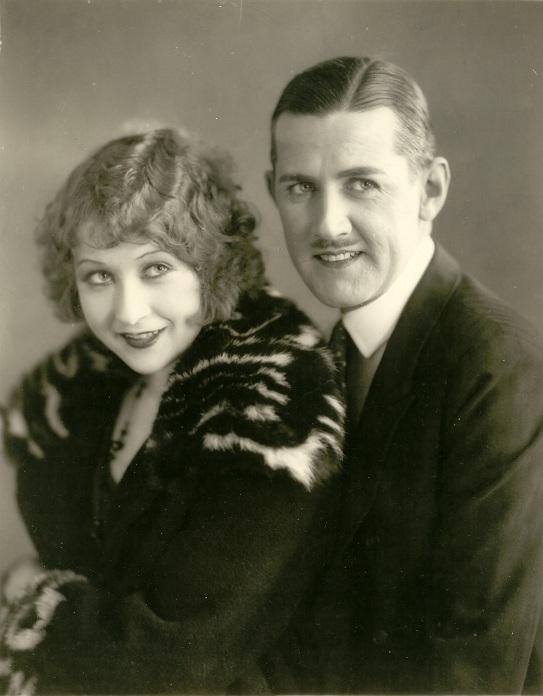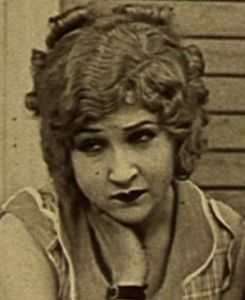
Katherine Grant's biographical details, thus far, have been sketchy at best. However, thanks to some impressive detective work, film historian Bill Cappello has recently been able to uncover some more information on Grant's life, the tragic and premature end of her film career, and her sad final years. While her life was marked by tragedy, her surviving film appearances reveal a gifted and subtle comic actress. Despite her regrettably brief film career, Katherine Grant had left an indelible mark on the Charley Chase series.

Katherine Grant had a promising career in movies, and was destined for film stardom, appearing in several dozen short comedies opposite several popular actors of the early 1920s, most notably Stan Laurel and Charley Chase. But her career was cut short by an accident which apparently exacerbated an underlying nervous condition.
Katherine May Grant was born May 1, 1904, in Los Angeles, California, the second child of John Edward Grant and Anita May Whiteman. Her father was born in Hulme, Lancashire, England, in 1877, and his family emigrated to the United States in the early 1880s. He met Pennsylvania-born Anita Whiteman, born in 1878, in Los Angeles, and they married on April 20, 1900. Their first child, son Chester Lonzelle Grant was born August 23, 1901.
John Grant was a carpenter, and tried his hand at some other trades. It may have been his ever-changing employment which caused instability in his family life. He and Anita divorced in 1919, and he moved to San Francisco with 18 year-old son Chester. Katherine continued living in Los Angeles with her mother (who remarried in 1920 to Frederick W. Kerr, a construction worker). John died September 14, 1921, age 43. His occupation at the time of his death was automobile salesman.
Katherine grew up to be a beautiful young lady. Soon after turning 18 in 1922, encouraged by her mother, she entered the "Miss Los Angeles Beauty Contest". There were many beautiful young ladies all vying for the prize, but in the end it was Katherine who was awarded the "Miss Los Angeles" crown. She was offered a contract by Hal Roach, the movie producer, and began her movie career, appearing in small roles in a few "Little Rascals" comedies.
As "Miss Los Angeles", Katherine entered the "Miss America" contest in Atlantic City, New Jersey in early September, joining fifty-six other girls from as many cities around the country, all competing for the title crown. The ultimate winner of that title was another "Katherine" - Mary Katherine Campbell, "Miss Columbus (Ohio)".
There was an incident at this time which caused some anxiety for Katherine. A few months earlier she was hired by a woman, an agent for a photography studio, to pose for a series of photos, described as an "art study", to be used by a sculptor who was creating a fountain. The photos, which featured Katherine in artfully nude poses, were taken before she entered the "Miss Los Angeles" contest.
When Katherine was in Atlantic City for the "Miss America" contest, she saw copies of the photos she believed were made solely for use by the sculptor. She was understandably upset, especially when she learned they were available in a variety of outlets. She was determined to cease their distribution. However, before she saw the photos, she was offered a twelve-week contract to appear as a dancer at a New York resort. She fulfilled her contractual obligation, then returned home in December.
Upon her return to Los Angeles, she went to the photography studio and appealed to the two photographers to stop the sale of the photos, but they showed her a release form she had signed, "consenting to the publication and sale of photos taken July 9, 1922." At the time she signed it, she assumed the paper was a receipt for the payment she was paid for posing.
Soon after, Katherine was called on the phone by a third man who demanded "an extortionate fee for the return of the plates" to her; otherwise, he threatened "to cause a motion-picture producer [Hal Roach] to break the cinema contract" with her.
The distributor of the photographs, S.H. Wershon, who had a store on Sunset Boulevard, claimed the third man was acting without any authority from him or permission from the two photographers who supplied him with the prints. Wershon described the man as a former movie extra who saw Katherine's pictures in his store, and recognized her as a girl he had seen on a local movie lot. He said the man approached him and suggested the photos could be used in a blackmail plot, but he wanted no part of it, and chased the man away.
Katherine's attorney, Thomas Lipps, sought a warrant charging fraud against the photographers and attempted extortion against the former movie extra man. She admitted she made a mistake not reading the paper she signed, thinking it was a receipt, but that she trusted the woman who hired her, as well as the photographers, and never thought they would turn against her. She further said since she was a little girl she had "been taught the precept of 'Art for Art's sake,' and thought nothing of posing for the sculptor," but greatly objected to having her pictures obtained through fraud and circulated against her wishes. She was confident the authorities would help her in her case.
Interestingly, there were no followup articles pertaining to the outcome of the case. It can be assumed that it was favorable for Katherine, because she continued with her movie career, appearing in many movies for Hal Roach over the next couple of years.
On December 8, 1925, Katherine was the victim of a hit-and-run accident while crossing a street near the Hal Roach Studios. The driver of the car was identified as a teenaged male, but none of the witnesses obtained the license number of the car, and he was never found. Katherine was taken to the hospital where she was evaluated for internal and possibly spinal injuries. Fortunately, there were no physical injuries, but doctors advised Katherine to take a prolonged rest from working. She would have none of it, thinking she would jeopardize her chances for movie stardom. She was up and working in a few days and completed two more movies.
In May 1926, it was discovered Katherine was in a sanatorium, under the assumed name of Ruth Woods to avoid publicity, in the care of a doctor who attributed her condition directly to the accident. Dr. Victor Parkin, a psychiatrist, said she suffered shock from the accident, and after several months, the shock launched her into a nervous and physical breakdown. He decreed that a prolonged period of "absolute quiet and rest were imperative or the girl's life was in danger." It was Hal Roach's suggestion she be taken to a sanatorium "where she could have complete rest...and not be accessible to even close friends, who, well meaning enough, might hurt her chances for recovery." The Roach Studios paid for all the expenses.
Hal Roach had only praise for Katherine as an actress, saying she was "one of the most avid students of film technique" from the time he signed her to a five-year contract two years prior. He continued: "She screened perfectly, and in my opinion developed into the most proficient actress in the profession. We had grown to expect great things of her and for her until this happened."

Katherine's mother, Mrs. Anita Grant Kerr, had her own comments to interject about her daughter's condition. "Some of the things that have been said about her are breaking my heart. She's just a sick child, there's no mystery at all about her illness." She went on to say, "Katherine worked hard in pictures, and then she was hurt in the accident. She finished two pictures after that, but it was too much. She had been dieting and not eating right, to keep her weight down, and all of those things were just too much." Mrs. Kerr soon after would take Katherine home, and Dr. Parkin would continue to care for her.
Eventually, Katherine's condition worsened, and she required complete care, something her mother could no longer provide. She was admitted to the Patton State Hospital in San Bernardino County, where she lived for the rest of her life. She died, as Katherine Kerr, April 2, 1937, age 32. Referencing her death certificate, the principal cause of death was pulmonary tuberculosis, with a contributing cause given as dementia praecox psychosis.
On the 5th of April, following a funeral service at the W.A. Brown Mortuary in Los Angeles, she was buried in the Evergreen Cemetery. Her grave is located in Section E, Lot Resub 120.
Katherine was mentioned in the January 1929 issue of Photoplay magazine. The article, "Diet - The Menace of Hollywood" by Katherine Albert, stated "The Miss Los Angeles of a few years ago was Kathryn [sic] Grant. A film career was assured when she was given a long term contract with the Hal Roach Studio. Pretty, talented---but overweight. She must lose. The pounds HAD to come off. She went on a diet so strenuous she collapsed and was rushed to a sanitarium. Today you do not see her on the screen. Hollywood has forgotten her. She has dropped out completely from the film world."
Katherine Grant may have been forgotten at that time, but she is remembered today for her movies with Stan Laurel and Charley Chase.
Sources:
"Scores Of Beauties Headed For Pageant," The New York Times, September 5, 1922
"Beauty Charges Plot in Posing for Photos," The Los Angeles Times, February 26, 1923
"Among Those Present - A New Comedy Vamp," Picture-Play Magazine, August 1925
"Motorist Flees After Injuring Screen Actress," The Los Angeles Times, December 9, 1925
"Fame Hopes Crushed By Car Wheels," The Los Angeles Times, May 7, 1926
"Miss Grant Will Rest in Country," The Los Angeles Times, May 10, 1926
"Diet - The Menace of Hollywood," Photoplay Magazine, January 1929
Katherine Grant death certificate (as Katherine Kerr), April 2, 1937, San Bernardino County, California
Photo of Charley Chase and Katherine Grant courtesy of Peter Mikkelsen.